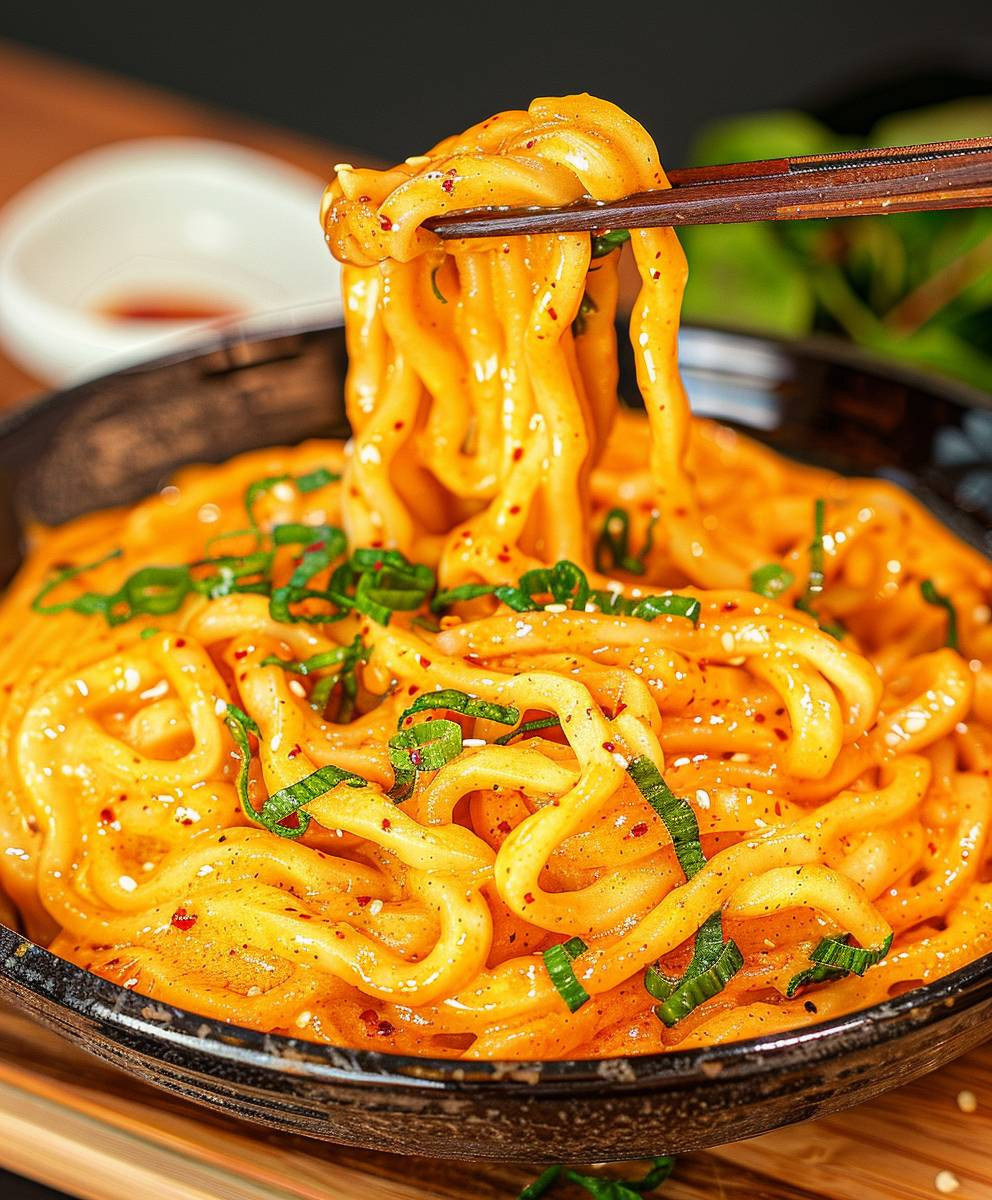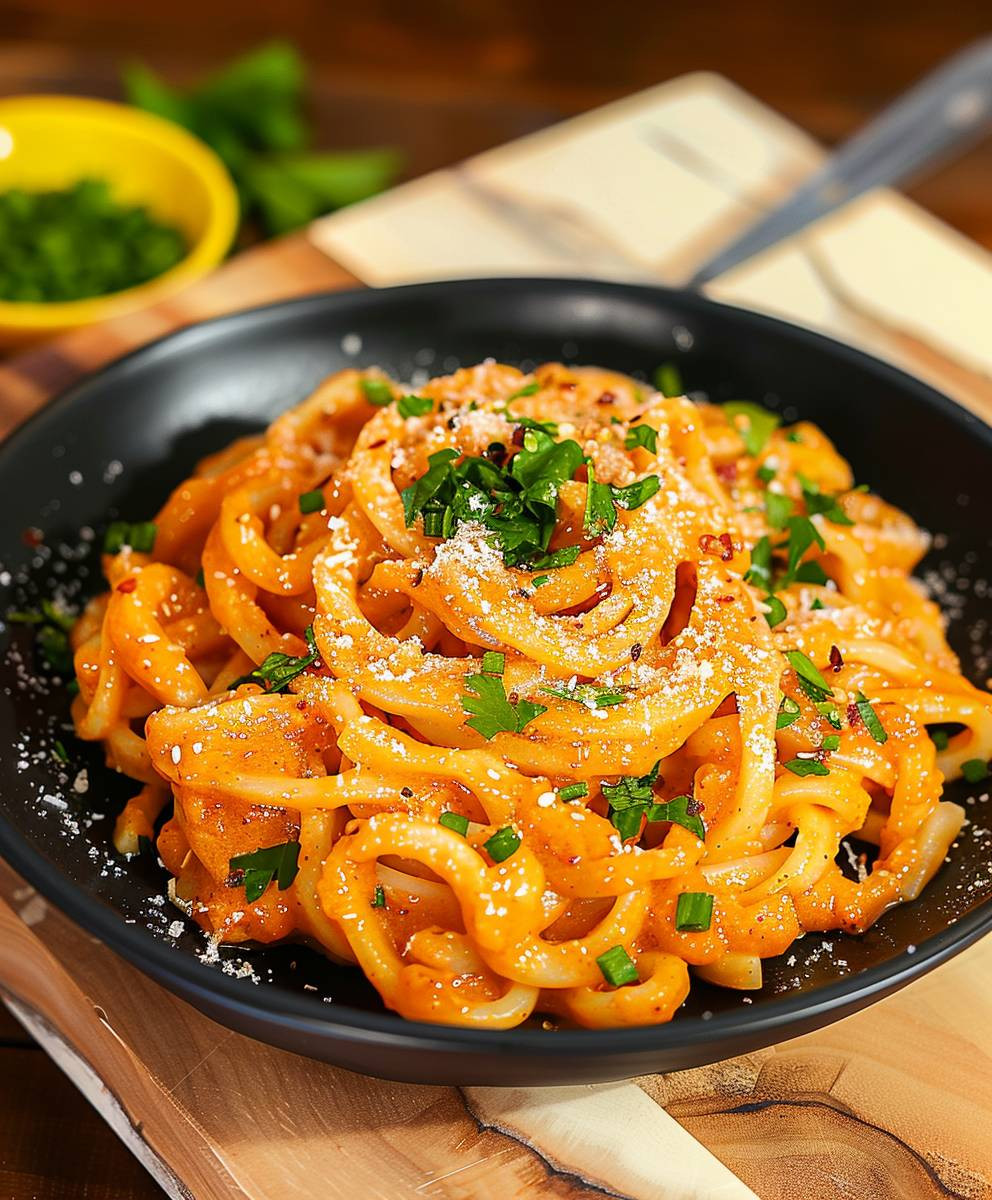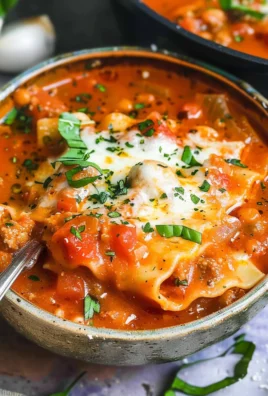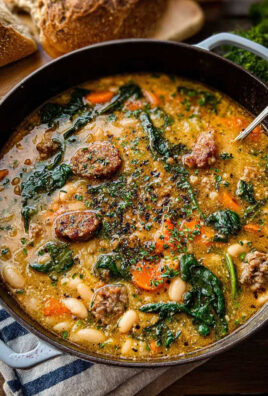Gochujang Udon Noodles: Prepare to embark on a flavor journey that will tantalize your taste buds and leave you craving more! Imagine thick, chewy udon noodles, slicked in a vibrant, spicy-sweet sauce that clings to every strand. This isn’t just a meal; it’s an experience.
Gochujang, the star of this dish, is a fermented Korean chili paste with a history as rich and complex as its flavor profile. For centuries, it has been a staple in Korean cuisine, adding depth and warmth to countless dishes. Its unique umami notes, combined with its fiery kick, make it an irresistible ingredient.
What makes Gochujang Udon Noodles so universally loved? It’s the perfect marriage of textures and tastes. The satisfying chewiness of the udon contrasts beautifully with the smooth, slightly sticky sauce. The gochujang provides a delightful heat that’s balanced by a subtle sweetness, creating a symphony of flavors that dance on your palate. Plus, it’s incredibly quick and easy to make, making it a perfect weeknight meal for busy individuals and families alike. I find myself making this dish at least once a week!
Ready to discover your new favorite noodle dish? Let’s get cooking!
Ingredients:
- For the Noodles:
- 12 oz package of dried Udon noodles
- For the Gochujang Sauce:
- 2 tablespoons Gochujang (Korean chili paste)
- 2 tablespoons soy sauce
- 1 tablespoon honey (or maple syrup for vegan option)
- 1 tablespoon rice vinegar
- 1 tablespoon sesame oil
- 1 teaspoon grated ginger
- 2 cloves garlic, minced
- 1/4 cup water (or more, to adjust consistency)
- For the Vegetables:
- 1 tablespoon vegetable oil (or any neutral oil)
- 1 cup sliced mushrooms (shiitake, cremini, or button)
- 1 cup sliced bell peppers (any color)
- 1/2 cup sliced onion
- 1 cup baby spinach
- For Garnish (Optional):
- Sesame seeds
- Chopped green onions
- Fried egg (sunny-side up or over-easy)
- Kimchi
- Chili flakes
Preparing the Gochujang Sauce:
This sauce is the heart of the dish, and it’s super easy to whip up! I like to make it first so the flavors have time to meld while I’m prepping the other ingredients.
- In a medium bowl, whisk together the Gochujang, soy sauce, honey (or maple syrup), rice vinegar, sesame oil, grated ginger, and minced garlic.
- Add the water, one tablespoon at a time, whisking until the sauce reaches your desired consistency. I usually aim for a slightly thick but pourable sauce. You can always add more water later if needed.
- Taste the sauce and adjust the seasonings to your liking. If you prefer a sweeter sauce, add a little more honey. For a spicier kick, add a pinch of chili flakes (or more Gochujang, if you’re brave!). If it’s too spicy, add a touch more honey or soy sauce.
- Set the sauce aside while you prepare the noodles and vegetables.
Cooking the Udon Noodles:
Cooking the udon noodles correctly is crucial for the best texture. Overcooked noodles will be mushy, and undercooked noodles will be too firm. Follow these steps for perfectly cooked udon every time!
- Bring a large pot of water to a rolling boil. Make sure you have enough water so the noodles don’t stick together.
- Add the dried udon noodles to the boiling water.
- Cook the noodles according to the package directions. This usually takes about 8-10 minutes, but it can vary depending on the brand. I always recommend checking the noodles a minute or two before the recommended time to ensure they don’t overcook.
- To test for doneness, carefully remove a noodle from the pot and taste it. It should be tender but still slightly chewy.
- Once the noodles are cooked to your liking, drain them immediately in a colander.
- Rinse the noodles under cold water to stop the cooking process and remove excess starch. This will also prevent them from sticking together.
- Set the cooked noodles aside.
Stir-Frying the Vegetables:
The vegetables add a wonderful layer of flavor and texture to the dish. I like to use a combination of mushrooms, bell peppers, and onions, but you can use any vegetables you enjoy. The key is to stir-fry them quickly over high heat so they retain their crispness.
- Heat the vegetable oil in a large skillet or wok over medium-high heat.
- Add the sliced mushrooms and cook for 3-5 minutes, or until they are softened and slightly browned.
- Add the sliced bell peppers and onion to the skillet and cook for another 3-5 minutes, or until they are tender-crisp.
- Add the baby spinach to the skillet and cook for just a minute or two, until it wilts. Be careful not to overcook the spinach, as it can become mushy.
- Remove the vegetables from the skillet and set aside.
Bringing it All Together:
This is where the magic happens! We’ll combine the noodles, sauce, and vegetables to create a delicious and satisfying meal.
- Add the cooked udon noodles to the same skillet or wok you used to cook the vegetables.
- Pour the Gochujang sauce over the noodles.
- Toss the noodles and sauce together until the noodles are evenly coated.
- Add the stir-fried vegetables to the skillet.
- Toss everything together to combine.
- Cook for another 1-2 minutes, or until the noodles and vegetables are heated through.
Serving and Garnishing:
Now for the best part – serving and enjoying your Gochujang Udon Noodles! I love to add a variety of garnishes to enhance the flavor and presentation.
- Divide the noodles and vegetables among bowls.
- Garnish with sesame seeds, chopped green onions, and chili flakes (if desired).
- For an extra touch, top each bowl with a fried egg (sunny-side up or over-easy). The runny yolk adds a richness and creaminess to the dish.
- Serve immediately and enjoy! You can also serve with a side of kimchi for an extra kick of flavor.
Tips and Variations:
- Protein: Add protein such as tofu, chicken, beef, or shrimp to make it a more substantial meal.
- Vegetables: Feel free to use any vegetables you like, such as broccoli, carrots, zucchini, or bok choy.
- Spice Level: Adjust the amount of Gochujang to control the spice level.
- Vegan Option: Use maple syrup instead of honey and ensure all other ingredients are vegan-friendly.
- Make Ahead: The sauce can be made ahead of time and stored in the refrigerator for up to 3 days.
Enjoy your homemade Gochujang Udon Noodles!
Conclusion:
Okay, friends, let’s be honest – you’ve scrolled this far because something about these Gochujang Udon Noodles whispered your name, right? And I’m here to tell you, that whisper was spot on. This isn’t just another noodle dish; it’s a flavor explosion waiting to happen, a weeknight dinner savior, and a guaranteed crowd-pleaser all rolled into one gloriously spicy, chewy package.
Why is this a must-try? Because it’s ridiculously easy. Seriously, if you can boil water and stir a sauce, you’ve got this. But more importantly, it’s the taste. The gochujang brings that signature Korean heat and umami depth, balanced perfectly by the sweetness of the honey and the savory notes of the soy sauce. The udon noodles, with their satisfyingly thick and chewy texture, soak up all that delicious sauce, ensuring every bite is bursting with flavor. It’s a symphony of textures and tastes that will leave you craving more.
But the best part? It’s totally customizable! Feeling adventurous? Add some kimchi for an extra layer of fermented goodness. Want more protein? Toss in some grilled chicken, shrimp, or tofu. Vegetarian? Load it up with extra veggies like bell peppers, mushrooms, or spinach. The possibilities are endless!
Serving Suggestions and Variations:
* For a complete meal, serve these noodles with a side of steamed broccoli or a simple cucumber salad.
* Garnish with sesame seeds, chopped scallions, and a drizzle of sesame oil for extra flavor and visual appeal.
* If you’re sensitive to spice, start with a smaller amount of gochujang and add more to taste.
* For a creamier sauce, stir in a tablespoon of mayonnaise or Greek yogurt at the end.
* Try using different types of noodles, such as soba or ramen, for a different texture.
* Add a fried egg on top for extra richness and protein. The runny yolk mixes beautifully with the sauce.
* Consider adding a squeeze of lime juice for a touch of acidity to brighten the flavors.
* If you have leftover cooked meat, like shredded pork or beef, this is a fantastic way to use it up.
I truly believe that this Gochujang Udon Noodles recipe will become a staple in your kitchen. It’s quick, easy, versatile, and, most importantly, incredibly delicious. It’s the kind of dish that you can whip up on a busy weeknight or impress your friends with at a dinner party.
So, what are you waiting for? Grab your ingredients, put on some music, and get cooking! I promise you won’t regret it. And once you’ve tried it, I’d absolutely love to hear what you think. Did you add any special ingredients? Did you make any modifications? Share your creations and experiences in the comments below! Let’s build a community of Gochujang Udon Noodle enthusiasts! I can’t wait to see what you come up with. Happy cooking!
Gochujang Udon Noodles: A Spicy & Delicious Recipe
Savory and spicy Gochujang Udon Noodles with stir-fried vegetables, coated in a flavorful Korean chili sauce. A quick and easy weeknight meal!
Ingredients
Instructions
Recipe Notes
- Protein: Add protein such as tofu, chicken, beef, or shrimp to make it a more substantial meal.
- Vegetables: Feel free to use any vegetables you like, such as broccoli, carrots, zucchini, or bok choy.
- Spice Level: Adjust the amount of Gochujang to control the spice level.
- Vegan Option: Use maple syrup instead of honey and ensure all other ingredients are vegan-friendly.
- Make Ahead: The sauce can be made ahead of time and stored in the refrigerator for up to 3 days.






Leave a Comment